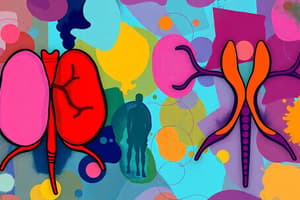Podcast
Questions and Answers
What distinguishes endocrine glands from exocrine glands?
What distinguishes endocrine glands from exocrine glands?
- Endocrine glands include sweat and salivary glands.
- Endocrine glands have no functional unit of cells.
- Endocrine glands release products through ducts to the surface.
- Endocrine glands secrete products directly into the bloodstream. (correct)
Which of the following glands is classified as an exocrine gland?
Which of the following glands is classified as an exocrine gland?
- The thyroid gland
- Mammary glands (correct)
- Pituitary gland
- Adrenal gland
Which statement accurately describes hyperthyroidism?
Which statement accurately describes hyperthyroidism?
- Hyperthyroidism corresponds with decreased metabolism.
- Hyperthyroidism is also known as hypothyroidism.
- The thyroid gland produces insufficient hormones.
- The thyroid gland produces hormones in excess. (correct)
What is a common symptom of hypothyroidism?
What is a common symptom of hypothyroidism?
What is the primary function of an exocrine gland?
What is the primary function of an exocrine gland?
Which gland is primarily involved in regulating the body’s metabolism?
Which gland is primarily involved in regulating the body’s metabolism?
What effect does an overactive thyroid likely cause?
What effect does an overactive thyroid likely cause?
Which of the following is a function of endocrine glands?
Which of the following is a function of endocrine glands?
What is an example of a condition resulting from underactive thyroid function?
What is an example of a condition resulting from underactive thyroid function?
Which characteristic is NOT typical of exocrine glands?
Which characteristic is NOT typical of exocrine glands?
Which medication is the first line of treatment for hyperthyroidism?
Which medication is the first line of treatment for hyperthyroidism?
What role do active metabolites of vitamin D play in bone health?
What role do active metabolites of vitamin D play in bone health?
Which condition is treated with cinacalcet?
Which condition is treated with cinacalcet?
What is a primary function of progestins?
What is a primary function of progestins?
Which of the following summarizes an aspect of type 2 diabetes?
Which of the following summarizes an aspect of type 2 diabetes?
Which should be avoided when injecting insulin?
Which should be avoided when injecting insulin?
How does a wearable insulin pump function?
How does a wearable insulin pump function?
What is the action of testosterone as an androgen?
What is the action of testosterone as an androgen?
What side effect is commonly associated with hypothyroid treatments?
What side effect is commonly associated with hypothyroid treatments?
What is the main purpose of blood tests for patients taking thyroid hormone treatments?
What is the main purpose of blood tests for patients taking thyroid hormone treatments?
Which medication is specifically preferred for pregnant women with hyperthyroidism due to its lower risk of birth defects?
Which medication is specifically preferred for pregnant women with hyperthyroidism due to its lower risk of birth defects?
What is one common side effect of using insulin pens?
What is one common side effect of using insulin pens?
What is the role of parathyroid hormone in maintaining calcium levels in the body?
What is the role of parathyroid hormone in maintaining calcium levels in the body?
How does an insulin pump deliver insulin to the body?
How does an insulin pump deliver insulin to the body?
Which is a reason progestins are prescribed aside from regulating the menstrual cycle?
Which is a reason progestins are prescribed aside from regulating the menstrual cycle?
What effect does vitamin D metabolites have on calcium and phosphate homeostasis?
What effect does vitamin D metabolites have on calcium and phosphate homeostasis?
Which process is necessary for the effectiveness of synthetic thyroid hormone treatments?
Which process is necessary for the effectiveness of synthetic thyroid hormone treatments?
Which of the following correctly defines the primary function of an endocrine gland?
Which of the following correctly defines the primary function of an endocrine gland?
Which condition is characterized by the overproduction of thyroid hormones?
Which condition is characterized by the overproduction of thyroid hormones?
What characterizes type 1 diabetes in regards to insulin production?
What characterizes type 1 diabetes in regards to insulin production?
Which side effect is often linked with hyperthyroid medication treatments?
Which side effect is often linked with hyperthyroid medication treatments?
What are common symptoms associated with hyperthyroidism?
What are common symptoms associated with hyperthyroidism?
Which characteristic distinguishes testosterone among androgens?
Which characteristic distinguishes testosterone among androgens?
Which gland plays a crucial role in hormonal regulation of the body's metabolic activities?
Which gland plays a crucial role in hormonal regulation of the body's metabolic activities?
Which of the following accurately describes the secretion method of exocrine glands?
Which of the following accurately describes the secretion method of exocrine glands?
What typically occurs in the body when the thyroid gland is underactive?
What typically occurs in the body when the thyroid gland is underactive?
Which gland is primarily responsible for the production of adrenaline?
Which gland is primarily responsible for the production of adrenaline?
Hypothyroidism can lead to which of the following conditions?
Hypothyroidism can lead to which of the following conditions?
What is a primary characteristic that distinguishes endocrine glands from other gland types?
What is a primary characteristic that distinguishes endocrine glands from other gland types?
Flashcards
Gland
Gland
A group of cells that work together to release specific substances.
Exocrine Gland
Exocrine Gland
Releases substances through a duct onto an epithelial surface, like skin or the lining of the mouth.
Endocrine Gland
Endocrine Gland
Releases substances directly into the bloodstream.
What are the major types of glands?
What are the major types of glands?
Signup and view all the flashcards
Sweat gland
Sweat gland
Signup and view all the flashcards
Salivary gland
Salivary gland
Signup and view all the flashcards
Mammary gland
Mammary gland
Signup and view all the flashcards
Adrenal gland
Adrenal gland
Signup and view all the flashcards
Pituitary gland
Pituitary gland
Signup and view all the flashcards
Thyroid gland
Thyroid gland
Signup and view all the flashcards
Hyperthyroidism Treatment
Hyperthyroidism Treatment
Signup and view all the flashcards
Hypothyroidism Treatment
Hypothyroidism Treatment
Signup and view all the flashcards
Vitamin D's Role in Bone Health
Vitamin D's Role in Bone Health
Signup and view all the flashcards
Parathyroid Hormone's Function
Parathyroid Hormone's Function
Signup and view all the flashcards
Cinacalcet for Hyperparathyroidism
Cinacalcet for Hyperparathyroidism
Signup and view all the flashcards
Progestins: Functions
Progestins: Functions
Signup and view all the flashcards
Estrogen Receptor Modulators (ERMs)
Estrogen Receptor Modulators (ERMs)
Signup and view all the flashcards
Androgens: Male Sex Hormones
Androgens: Male Sex Hormones
Signup and view all the flashcards
Type 1 Diabetes
Type 1 Diabetes
Signup and view all the flashcards
Type 2 Diabetes
Type 2 Diabetes
Signup and view all the flashcards
What is a gland?
What is a gland?
Signup and view all the flashcards
Hyperthyroidism
Hyperthyroidism
Signup and view all the flashcards
Hypothyroidism
Hypothyroidism
Signup and view all the flashcards
What are the key differences between endocrine and exocrine glands?
What are the key differences between endocrine and exocrine glands?
Signup and view all the flashcards
What are some examples of exocrine glands?
What are some examples of exocrine glands?
Signup and view all the flashcards
What are some examples of endocrine glands?
What are some examples of endocrine glands?
Signup and view all the flashcards
How does hyperthyroidism affect the body?
How does hyperthyroidism affect the body?
Signup and view all the flashcards
How does hypothyroidism affect the body?
How does hypothyroidism affect the body?
Signup and view all the flashcards
Vitamin D and Bone Health
Vitamin D and Bone Health
Signup and view all the flashcards
Parathyroid Hormone's Role
Parathyroid Hormone's Role
Signup and view all the flashcards
Study Notes
Introduction to Pharmacology and Toxicology
- Course title: Pharmacology and Toxicology
- Course subtitle: Principles of Endocrine Pharmacology
- Instructor: Wong Chun Keung
- Date: 30 September 2024
Difference Between Endocrine and Exocrine Glands
- Gland definition: Functional unit of cells working together, releasing products.
- Exocrine glands: Secrete products via ducts to epithelial surfaces.
- Examples: Sweat, salivary, mammary glands.
- Endocrine glands: Secrete products directly into the bloodstream.
- Examples: Adrenal, pituitary, thyroid glands.
Overactive Thyroid (Hyperthyroidism)
- Condition: Thyroid gland produces too much hormone.
- Side effects: Weight loss, nervousness, irregular pulse, irritability, sleep problems, vision problems, muscle weakness, feeling hot.
Underactive Thyroid (Hypothyroidism)
- Condition: Thyroid gland produces not enough hormone.
- Side effects: Weight gain, depression, forgetfulness, fatigue, dry skin, feeling cold.
Medications for Treating Hyperthyroidism
- First-line treatment: Methimazole (works quickly, few side effects)
- Treatment for pregnant women: Propylthiouracil (lower risk of birth defects)
- Treatment time: Usually takes 1-2 months to see symptom change.
Medications for Treating Hypothyroidism
- Treatment method: Replacing missing thyroid hormones (e.g., levothyroxine, liothyronine, liotrix) orally.
- Patient monitoring: Regular blood tests are necessary to adjust dosage as it varies among patients.
Pharmacology of Bone Mineral Homeostasis
- Vitamin D metabolites: Increase calcium absorption in bones and gut, promote calcium/phosphate homeostasis.
- Parathyroid hormone: Increases calcium reabsorption from bones, affects bone, gut and kidney function, maintains serum calcium levels.
- Reciprocal effect: Parathyroid hormone and Vitamin D metabolites reduce urinary calcium excretion.
Medication for Hyperparathyroidism
- Medication: Cinacalcet
- Use: Treats hyperparathyroidism, especially if surgery isn't an option.
- Action: Decreases parathyroid hormone production, thus lowering blood calcium levels.
- Note: A medication called Cinacalcet (Sensipar) is commonly used for the treatment of hyperparathyroidism, often when surgery isn't considered
Progestins Prescription
- Function: Help other hormones work properly, regulate menstrual periods, prevent anemia, reduce menstrual blood loss, prevent uterine cancer.
- Use: Combined with estrogens for contraceptives.
Estrogen Receptor Modulators
- Use: Treat osteoporosis, postmenopausal symptoms, breast cancer.
- Action: Treat hormone receptor-positive breast cancers by blocking estrogen receptors, preventing growth-stimulating effects.
Medication Specifically for the Male Reproductive System
- Hormone: Androgens (testosterone)
- Function: Main male sex hormone. Important for sexual development, reproductive function, and secondary sexual characteristics like facial/body hair growth and voice change.
Diabetes Type 1 and Type 2
- Type 1 diabetes: Lifelong condition where the body's immune system attacks insulin-producing cells.
- Type 2 diabetes: Body produces insufficient insulin or the body's cells don't respond to insulin properly.
Medicine for Type 1 Diabetes
- Treatment: Insulin
- Delivery method: Injection, or via a small insulin pump.
Insulin Pen
- Introduction: Alternative to vials and syringes, introduced in the late 1980s.
- Action: Contains insulin to lower blood glucose levels in people with diabetes.
- Delivery system: Convenient, simple, and accurate method for injecting insulin.
- Application steps: Adding a new needle, dialing a dose, injecting insulin, safely disposing of the used needle.
Steps for Using the Insulin Pen
- Preparation: Removing the pen from refrigeration, allowing it to reach room temperature, washing hands, cleaning the injection site.
- Needle attachment: Attaching a new needle, ensuring it's straight, removing caps.
- Air removal: Removing air bubbles.
- Dosage: Selecting correct dose.
Body Sites for Injecting Insulin
- Injection sites: Upper outer arms, abdomen, buttocks, and upper outer thighs.
- Benefits of injection sites: Abdomen is fastest absorption. Avoid injecting wounds or bruised areas. Alternate locations for each injection.
Injection of Insulin with a Pen
- Instructions: Cleaning the skin, holding the skin, inserting the needle, injecting insulin, removing the needle, replacing the pen cap, storing.
Insulin Pump
- Alternative to insulin injections: Wearable device.
- Action: Delivers insulin continuously with continuous flow under the skin. Easier and painless for taking additional insulin as needed, removing the need for injections.
Studying That Suits You
Use AI to generate personalized quizzes and flashcards to suit your learning preferences.




